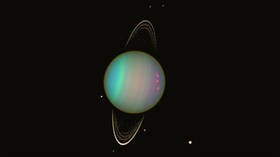Mystery of Uranus’ unique off-kilter tilt finally EXPLAINED by massive ancient impact

Uranus’ mysterious rotation pattern and its unusual rings have long puzzled scientists, but new research says that the planet’s peculiar properties are explained by a massive collision when the solar system was still young.
The icy giant stands out in the solar system as it is the only planet that doesn’t rotate with its poles at 90 degrees to the axis of gyration, instead marching to the beat of its own drum with a 98 degree tilt.
From an Earth observer’s point of view that makes it seem as if the seventh planet from the sun wobbles as it spins. It also has a ring system and more than two dozen moons that orbit around it at the same tilt.
Also on rt.com Mars Perseverance rover kitted out with new wheels & brakes as mission looms (PHOTOS)A new study has finally unravelled the mystery of these peculiar characteristics, claiming that Uranus was walloped by a smaller icy planet in the early days of the solar system, tipping it off kilter and leaving the slew of moons in its wake.
It also sped up the planet’s rotation period, which is why a day on Uranus lasts only 17 hours. Researchers believe that such catastrophic crashes were more common in the early solar system.
According to the team of Japanese scientists an enormous impact on distant icy planets would be completely different from those involving rocky planets that are closer to the Sun. The boffins say their model is the first to explain the configuration of Uranus' moon system, and it may help explain the configurations of other icy planets in our solar system, such as Neptune.
“Beyond this, astronomers have now discovered thousands of planets around other stars, so-called exoplanets, and observations suggest that many of the newly discovered planets known as super-Earths in exoplanetary systems may consist largely of water ice, and this model can also be applied to these planets," professor Shigeru Ida from the Earth-Life Science Institute (ELSI) at Tokyo Institute of Technology added.
Also on rt.com Light up your lockdown: Pink supermoon on the way this weekLike this story? Share it with a friend!












